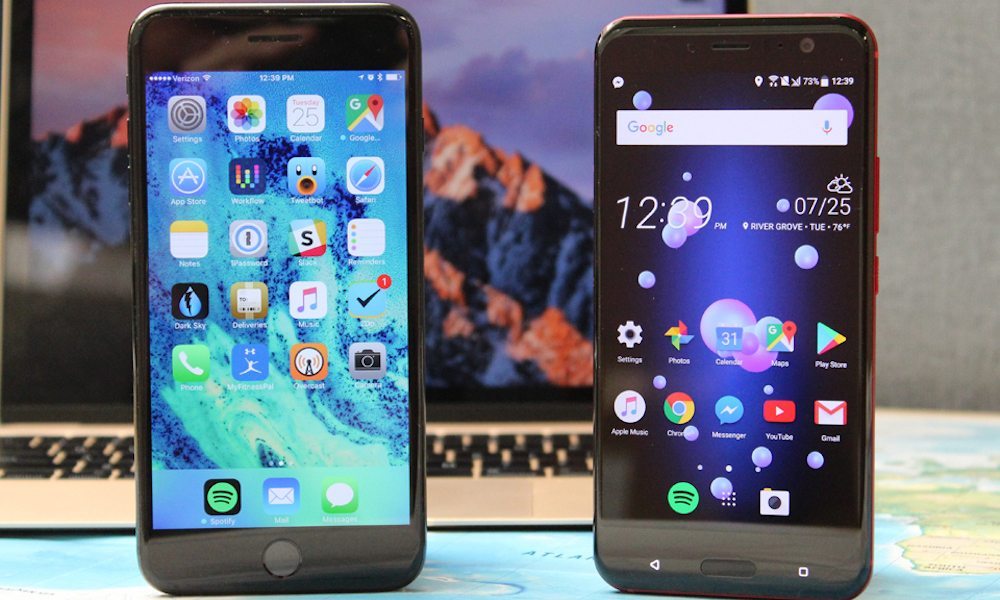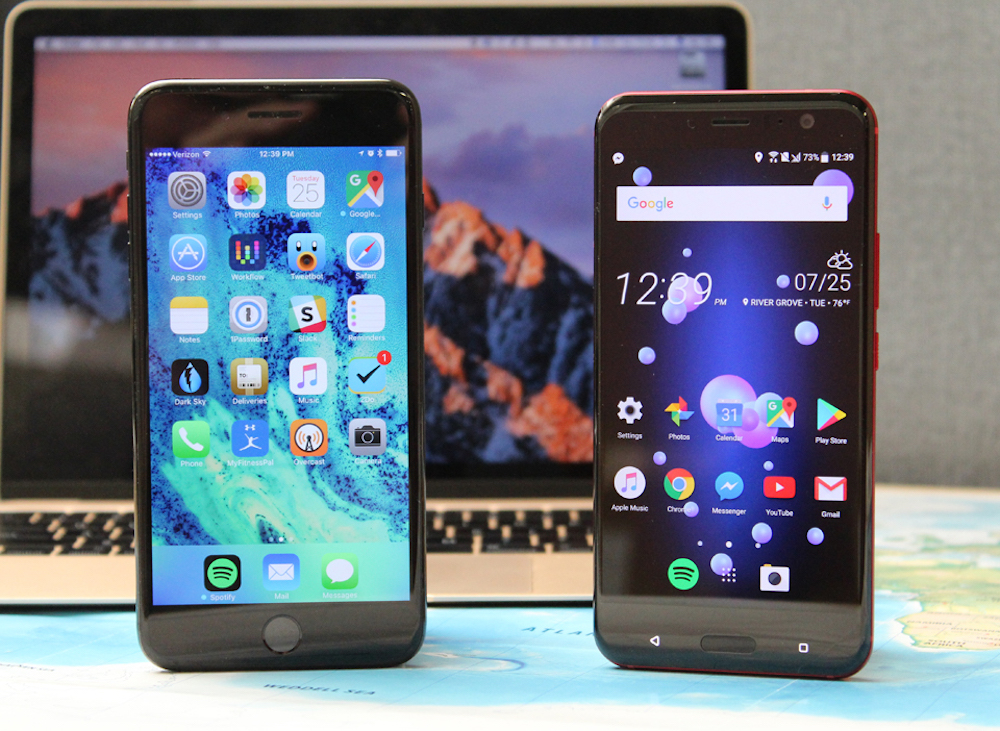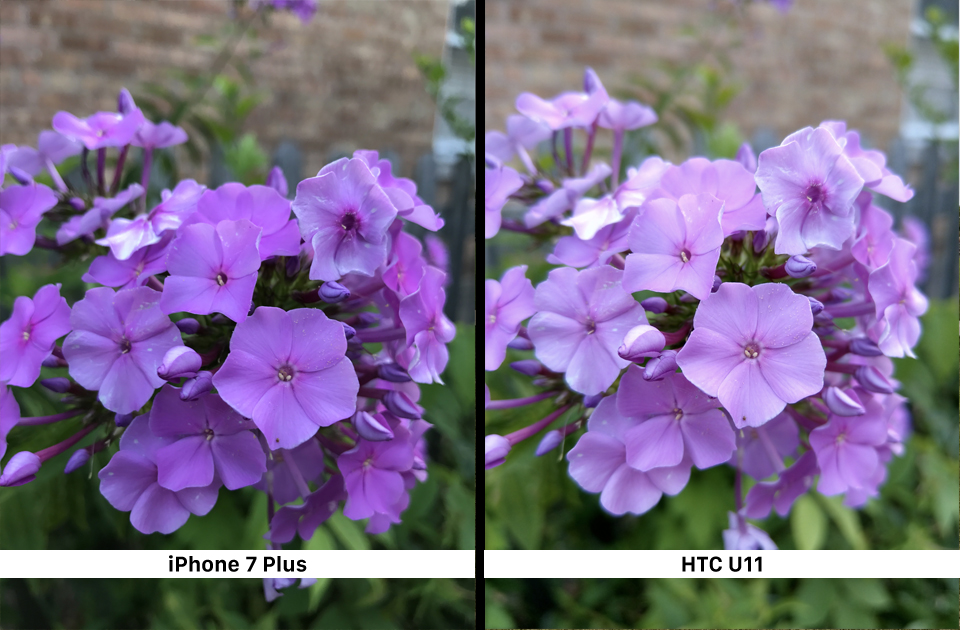iPhone 7 Plus vs HTC U11 Comparison Review

Images via Ian Fuchs / iDrop News
Toggle Dark Mode
Last September Apple released their latest and greatest additions to the iPhone lineup: the iPhone 7 and 7 Plus. Both feature the familiar design of their predecessors but include subtle changes to make them more powerful, more capable, more durable, and more beautiful. Nearly 9 months later, HTC launched the U11. Positioned as their new flagship device designed to go head-to-head with the iPhone 7 Plus and likely this fall’s iPhone 8. The U11 has received many positive reviews around the web, even netting a User Rating of 9.9 on PhoneArena. In a technical head-to-head, the HTC U11 and the iPhone 7 Plus are both incredible devices, but how do they compare beyond the spec sheet? Let’s dive in.
iPhone 7 Plus vs HTC U11 – Design

Smartphone design has more or less been consistent since the iPhone initially launched in 2007. Screen size, thickness, materials, and bezels change, but the rectangular-glass-inside-of-a-frame has been very consistent. The same holds true with the U11 and the iPhone 7 Plus.
The iPhone is 158.2 mm tall and 77.9 mm wide. The U11 comes in just slightly smaller, at 153.9 mm tall and 75.9mm wide. In hand, the devices feel nearly identical in size, so those few millimeters are pretty negligible. Not to be outdone on thinness, the iPhone 7 Plus does come in slightly thinner than the U11, at 7.3mm vs 7.9mm.
Holding the devices in hand, the .6mm difference in thickness is impossible to discern, but what does feel different is the physical construction of each device. As Apple highlighted in the iPhone release last fall, the 7 Plus features a glass face, a solid piece of aluminum for the body, and a completely flat back (except for the camera hump).
The U11 actually harkens back to the iPhone 4 and 4s construction, featuring an all glass front and back, with an aluminum frame around the edges. In hand, the front glass blends beautifully into the aluminum frame, but on the back, the U11 has a subtle bloat through the center of the device, tapering towards the sides, and a small lip at the edge that gives a slightly squared feeling, even with the rounded aluminum sides of the phone.
The decision by HTC to use glass may be controversial, as glass tends to damage easier than metal, but regardless, what they’ve done with the U11 is absolutely stunning. Whether it’s Sapphire Blue, Amazing Silver, Brilliant Black or Solar Red, the back of the U11 will catch your attention. Thanks to their “liquid glass” surfacing process, the back of the device is solid, vibrant, and slowly changes color in the light.

For example, the Solar Red model that I tested is bright red and will shift to gold in certain angles. Similarly, the Sapphire Blue model that I saw in store appears silver or purple, depending on your angle. This makes the device really pop.
Next to a Jet Black iPhone, which is incredibly shiny, the U11 is hard to ignore, and any of the iPhone’s less glossy finishes feel incredibly bland by comparison. Even the Product(Red) iPhone, which is a rich, gorgeous color, feels somewhat dull next to the glossy finish on the U11.
The rest of the physical design of the U11 and the iPhone walk hand-in-hand. The iPhone 7 Plus features a volume rocker and mute switch on the left side, power button on the right, and a home button on the chin. The U11 skips the physical mute switch and puts both volume and power on the right side of the device, and an oval shaped home button on the chin (along with the virtual soft keys for back and menu when the device is powered on).
Having volume down and power so close together is an interesting choice, and in a week of using the device, I inadvertently quieted the U11 about 5% of the times I attempted to lock the device.
On the bottom of each device, you’ll find a speaker and their charging port. No traditional 3.5mm headphone jacks found here. The charging and audio port on the iPhone is Apple’s proprietary Lightning connector, while the U11 went with USB-C. After charging the U11 a few times, it’s safe to say that when (or if) Apple adopts USB-C for the iPhone’s port, it’ll be a wonderful day. Being able to swap from charging my laptop to my phone and back, all with the same cable, is invaluable.
iPhone 7 Plus vs HTC U11 – Display

Moving away from the incredibly similar bodies of the devices, there’s even more to be found in common when it comes to the displays on these devices. Both the U11 and iPhone 7 Plus feature 5.5” displays, although the U11 sports a higher overall resolution on the panel. The iPhone 7 Plus’ screen displays 1920 x 1080, with a pixel density of 401ppi, while the U11 is rocking a 2560 x 1440 screen at 534ppi.
In real-world usage, the screen of the U11 definitely seemed more vivid, but at times, felt like the contrast was boosted to give the illusion of a better display. On-screen whites were very bright, and blacks were solidly black, but anything else felt a little unnatural.
By comparison, the iPhone’s display renders decent blacks, bright whites, accurate colors, and an overall brighter image. The U11 did feature some display enhancements to “personalize” things, but sticking with the defaults, it definitely felt more altered than the iPhone.
Both devices also feature some form of blue light reduction, meant for use in the dark. “Night Shift” on the iPhone vs. “Night Mode” on the U11 both reduced the blue tones on the screen, but the subtle orange tinting on the iPhone was much more pleasing to the eye than the redder tones of the U11.
iPhone 7 Plus vs HTC U11 – Battery Life

Pushing all those pixels is a good way to burn through your phone’s battery, but both devices did a nice job handling average usage and lasted as long as expected.
Inside the U11 is a 3000 mAh battery, equipped with QuickCharge 3.0. What this means is that in just 45 minutes, I was able to recharge the U11 from 20% to 90%.
From a full charge, the U11 lasted me a full day of listening to music, checking twitter, reading and replying to a handful of emails, watching the latest YouTube videos, and messaging friends. At the end of the day, I was left with around 25% battery, so there was easily enough to do more.
In the iPhone 7 Plus, a slightly smaller 2900mAh battery is also capable of getting me through a full day. One factor to consider here is that my iPhone 7 Plus is loaded down with apps, paired to my Apple Watch, and was my primary ‘phone’ during my testing period. Ultimately, iOS wins in overall battery life, simply based on the overall usage time the U11 got in comparison to my iPhone, and the remaining battery after a day of use.
The major difference U11 owners will see really comes down to the recharge time, as it blows the iPhone out of the water with the Quick Charge technology.
iPhone 7 Plus vs HTC U11 – Camera Quality

One of the most critical features of any smartphone in 2017 is the camera, and every flagship device has brought their A-game when it comes to cameras this year.
With the iPhone 7 Plus, Apple introduced its dual-lens system, allowing for both a wide angle and telephoto lens to be mounted on the back of the device. The primary lens, a f/1.8 28mm equivalent lens, produces stunning photos. The secondary lens, an f2.8 56mm equivalent, has some trade offs. It delivers slightly less crisp photos than the primary, but the resulting images are a notably higher quality when using the 2x optical zoom rather than the digital zoom (crop zoom) of other single-lens smartphones. Behind the scenes, Apple has put tremendous thought and attention into the photo processing software to produce consistently great photos.

On the U11, a single camera rides on the back of the device, with a f/1.7 26mm equivalent lens. This single lens is capable of producing very sharp, consistent photos, but the lack of impressive software processing for photos is a big drawback. Low-light photos were just okay, and the camera did a great job of autofocusing, even up close with moving subjects.

Overall, both devices produced excellent close-up photos and standard 1x photos. As expected, photos at 2x or greater zoom with the U11 were less sharp than the iPhone. iPhone photos also appeared slightly more vivid, with better contrast and color accuracy, and saturation.
The iPhone’s software smarts can also take advantage of the dual-lenses on the iPhone 7 Plus, creating a new photo feature, portrait mode, which turns “regular” photos into portraits with incredible, artificial depth of field. The iPhone also features panorama, time lapse, slow mo, and video mode, while the U11’s camera features panorama, time lapse, video, and photo.
In testing, video seemed to perform near-identically, with only minor variances in color between the devices. Auto-focus on the U11 in both video and photo modes seemed quicker, but the placement of the power button on the device caused a few missed photos when trying to use the volume button as the shutter.
iPhone 7 Plus vs HTC U11 – Hardware Features

The headlining hardware feature of the U11 – the one that has garnered much attention online – is the squeeze. The concept is simple and very accessible. After a quick setup, squeezing the sides of the U11 act as a shortcut to launch the camera. Squeeze again and the camera will snap a photo. It sounds like a gimmick, but it’s actually very useful.
Additionally, the squeeze can be mapped to launch other applications, although getting instantaneous access to the camera seemed most practical in testing. This is the kind of feature that many people laugh at, but once they try it, quickly realize it’s very useful. Without looking, you can pull the U11 from your pocket and have the camera already open, simply by squeezing as you draw. This means you’re less likely to miss those fleeting moments.
Unfortunately, as was the case a couple times for me, it also means it’s possible to activate the camera, in your pocket, accidentally. The squeeze pressure can be adjusted, but even at its firmest, I was able to unknowingly trigger it, and burn through battery with the camera open and the screen glowing inside of my pants pocket. Fortunately, the feature can be disabled in settings, if squeezing isn’t your favorite kind of smartphone gesture.
Speaker quality (and clarity) is also a headlining feature for both the iPhone 7 Plus and the U11. With the iPhone, Apple launched stereo speakers within the device, allowing for louder phone calls, music, podcasts, and anything you listen to. On the U11, HTC’s BoomSound technology is designed to do the same. The execution of BoomSound is a bit strange, by comparison. Instead of being an always-on feature, HTC made it a toggle on or off feature. When turned off (music mode), there is no additional amplification or equalization. When turned on, everything noticeably louder, but music was less crisp. In a head-to-head, the iPhone offered slightly less bass, but an overall clearer, louder sound, while the HTC had punch, but also came with distortion.
iPhone 7 Plus vs HTC U11 – Software Features
The most significant software factor separating the iPhone 7 Plus and the U11 boil down to the operating system. iOS vs Android has been a hot topic for the past few years, and the longer the war wages on, the more and more people fall on one side or the other.
The iPhone 7 Plus runs iOS 10.3.3 (with iOS 11 launching this fall), and the U11 runs the latest version of Android Nougat, 7.1.1. The iPhone has Siri, while the U11 packs the Google assistant. In addition to the standard “Ok Google” command, HTC and Amazon struck a deal with the U11, packing Alexa into the device as well.
Execution is a bit weird, requiring the device to be unlocked with the finger print sensor to utilize Alexa on the U11 – and what’s the point of voice commands if you have to touch it anyway – but Google assistant can be used hands-free, the same as Siri.
Additionally, the U11, by default, is running a custom skin of Android, specifically designed by HTC, which wasn’t particularly useful or helpful. Having used “pure” Android (a la Nexus or Pixel devices), the HTC Sense UI running on the U11 was distracting at best.
The Sense Assistant floated on the right side of the screen, offering suggestions about where to get gas or lunch, and offered a reminder to get my 10,000 steps in, but never when I needed to be reminded. The rest of the time, it was just a wart on the side of the screen.
Another software based feature of the U11, Blinkfeed, is what HTC opted to place at home screen zero. On the iPhone, this is the spotlight page, which features search, AI selected apps, news, weather, and whatever other widgets you select. Blinkfeed, on the other hand, attempts to be a one-stop-shop for your social feeds, news, and “other content.”
After setting up Twitter, Facebook, YouTube, and News Republic (the device’s built-in news curation service), Blinkfeed showed a blend of social media content, news stories, and advertisements. Having a single social feed might be useful for some, but having advertisements ingrained into the system is truly disgusting.
The Amazon Fire tablet with “special offers” gets to put ads on the lock screen to offset the rock bottom price of the device. The U11 has no right to place ads anywhere within the core of the operating system when you’re paying flagship price for the phone. Shame on HTC.
iPhone 7 Plus vs HTC U11 – Price & Availablity

Currently in the US, Sprint is the only carrier officially selling the U11. Before picking one up, I visited three different Sprint stores, and only one had the device in stock, a single Blue model.
Fortunately, Amazon and HTC both sell the device as well, and for the same price as Sprint. For $649, you can pick up the 64GB model, or bump up to 128GB for $729. The U11 does feature a microSD card slot, so expanding the storage isn’t an issue, so justifying the extra $80 is harder.
The iPhone 7 Plus starts at $769 for the 32GB model. You can bump up to 128GB for an additional $100, or 256GB for a whopping $969. When choosing an iPhone, considering capacity is more important, as there is no expandable storage.
Many carriers offer deals on the iPhone, though, and almost any US carrier sells the device, so while the price may not be quite as low, getting your hands on one is much easier.
Conclusion

Ultimately, both devices are very impressive. They are capable of taking excellent photos, handing calls and messaging, and even doing “real work.” Personal preference is the most important factor in deciding on a device, and knowing the U11 runs Android may scare off some iPhone users. Conversely, those Android lovers might find the U11 to be a very appealing device, while the iPhone might seem dull.
In my week of usage, I was surprised how far Android devices have come since 2009. I was equally surprised at how some things seemingly never change. The iPhone may not be the flashiest or most customizable device on the market, but it’s consistent, stable, and has a massive world of great apps available. The U11 is one of the prettiest Android devices I’ve ever seen and feels like an iPhone in hand – but the world of Android is full of unfortunate quirks, widgets, and cluttered status bars.
Either way, it’s safe to say that the iPhone 7 Plus is the best smartphone running iOS to date, and the HTC U11 is a solid competitor. If you ask me, Apple could stand to borrow a thing or two from the U11 to make the iPhone even more remarkable looking, and more functional, in the future – however Apple’s high-end iPhone 7 Plus is still the clear leader in quality and performance.
Winner: Apple iPhone 7 Plus






